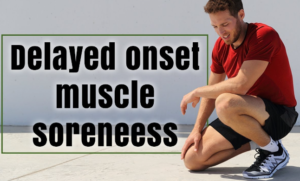If you exercise or participate in physical activity, you have probably experienced muscle stiffness or soreness the following day or up to two days after exercising. Muscle soreness and stiffness isn’t always avoidable and there are things we can do to reduce and relieve the delayed pain, making workouts more enjoyable.
What is DOMS?
Delayed Onset Muscle Soreness, commonly known as DOMS is the delayed onset of muscle soreness or stiffness that occurs following physical activity. It is a temporary condition that affects the muscles causing aches and pain a day or two after exercising. DOMS is caused by micro-trauma to the muscle fibres, which in turn causes inflammation and changes to fluid levels near the damaged muscles. It should not be seen as a setback in training but rather as a way that our body is telling us we have pushed a little too hard during our last exercise session.
When do people experience DOMS?
Muscle stiffness and soreness is commonly experienced 24hrs after exercise and persists for up to 3-7 days, many people see the peak of DOMS pain 48hrs post exercise. People with DOMS may find it hard to climb up and down a flight of steps, or to do simple activities of daily living such as standing up from a chair. Rest assured the pain is temporary.
How to reduce muscle soreness:
When we are injured, it is only natural to seek or look for ways to reduce pain. If you are experiencing DOMS, you could try taking a hot bath or shower. You could plunge into a cold ice bath or try using an ice pack on the sore area. Having a massage is a quick an effective way of relieving muscle tightness. Wearing compression clothing will help with blood flow and circulation to the sore muscles. Pain relief creams such as Voltaren are an effective topical treatment for muscle soreness. Taking an Epsom salt bath helps muscles to relax and boosts blood flow to the sore muscles. Using a foam roller reduces muscle tightness and stiffness while helping to lengthen muscle fibres. If all of the above feels like they are not working for you, the over-the-counter pain killers should be taken to reduce soreness.
Preventing muscle soreness:
Muscle soreness makes exercising the next day or 2 very difficult, below are a few preventive measures one can take to reduce the effects of DOMS to be able to stay active:
Warm up before you exercise: Before exercising it is important to spend between 5-10 minutes doing dynamic stretching or low impact cardio-vascular exercises such as cycling. Warming up your body helps to increase blood flow and loosen stiff muscles.
Cool-down after exercise: After exercise one should aim to spend 5-10 minutes performing static stretching to cool-down their body. Cool-downs are important as they reduce heart rate and body temperature.
Don’t overdo it: Doing more or lifting that one plate heavier than your body can handle leads to damaging your muscles, in turn leading to DOMS. We need to take is slow with gradual exposure to new weights.
Move on rest days:On your rest days it is important to keep moving as moving helps to stretch and loosen your muscles. Movement can be as simple as taking a walk or doing low resistance cardio.
Stay Hydrated:This may seem obvious, but it is easily overlooked. Staying hydrated with water allows our body to repair the micro-trauma the sore muscles have experienced. Drinking water also helps to remove toxins from the body.
Final Word:
Overall, when it comes to exercise muscle soreness and stiffness is inevitable. DOMS can be referred to as muscle soreness that creeps in 24hrs post exercise, it will generally persist for a few days, but it will go away quickly. The muscle soreness you are feeling is temporary. By following the above preventive measures, you are likely to reduce prolonged muscle aches and pains, allowing you to return to your regular exercise routine quicker.
If the muscle pain persists or you find yourself experiencing DOMS more often than not following an exercise session, it would be beneficial to seek professional help from an Exercise Physiologist, as they can provide you with an individualised exercise program that aims to prevent DOMS while helping to improve strength to the muscles you are trying to target when strength training.




